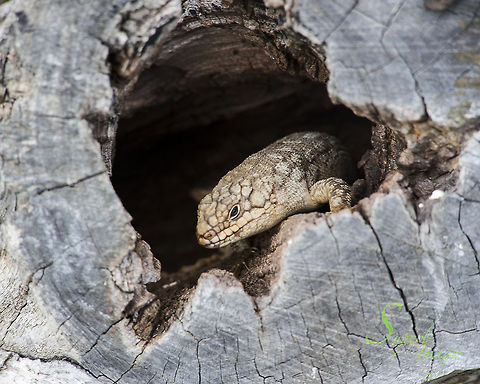
Appearance
This medium-sized skink has a relatively short tail with keeled scales along its dorsal surface from the back of the neck down to the tip of the pointed tail. The legs are quite short, requiring the lizard to slide on its belly when it moves around. Its colour can vary from dark brown to a rusty colour, with scattered patches of paler scales.Naming
The species is named in honour of Admiral John Lort Stokes who served with Charles Darwin on the HMS Beagle and charted the Houtman Abrolhos Islands in Western Australia, where the type specimen was first collected. The common name is derived from the species' association with Gidgee Trees (Acacia species).Subspecies
Egernia stokesii aethiops STORR 1978
Egernia stokesii badia STORR 1978
Egernia stokesii stokesii (GRAY 1845)
Egernia stokesii zellingi DE VIS 1884
Common Names
E: Gidgee Spiny-tailed Skink, Gidgee Skink, Stoke’s Skink
G: Stachelschwanzskink
Synonyms
Silubosaurus stokesii GRAY 1845: 105
Silubosaurus zellingi DE VIS 1884
Distribution
The species has a widespread (though broken) distribution across semi-arid Australia, from far west New South Wales to the south-western interior of Western Australia. They are also known from several islands off the west coast of Western Australia.stokesii: Houtman Abrolhos, West Australia.
aethiops: Baudin Island, Shark Bay, West Australia; Type locality: Baudin Island.
badia: mainland West Australia; Type locality: Rothsay.
zellingi: E Australia; Type locality: Barcoo, Queensland.
Type locality: W. A. and Houtman Abrolhos, W. A.
Status
Listed as Endangered as Egernia stokesii badiaListed as Vulnerable as Egernia stokesii aethiops
Habitat
The species occurs in shrubland and open woodland, and often on rock outcrops. Groups of Gidgee Skinks will shelter between rocks, split trees and logs, and within hollows.Reproduction
The breeding season in the wild differs based on location; females in South Australia have been recorded giving birth between mid-summer and early autumn, however, a wild-caught female from Western Australia gave birth in mid-winter.Food
These omnivorous lizards feed predominately on vegetation such as fruit and leaves in the wild, as well as any invertebrate they can catch.References:
Some text fragments are auto parsed from Wikipedia.
http://australianmuseum.net.au/Gidgee-Skinkhttp://reptile-database.reptarium.cz/species?genus=Egernia&species=stokesii
http://www.environment.gov.au/cgi-bin/sprat/public/publicspecies.pl?taxon_id=64483